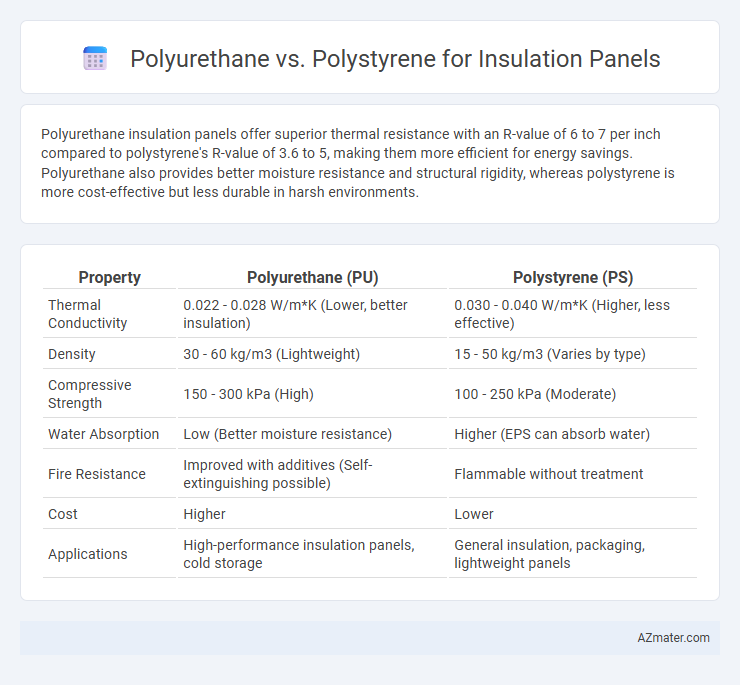Polyurethane insulation panels offer superior thermal resistance with an R-value of 6 to 7 per inch compared to polystyrene's R-value of 3.6 to 5, making them more efficient for energy savings. Polyurethane also provides better moisture resistance and structural rigidity, whereas polystyrene is more cost-effective but less durable in harsh environments.
Table of Comparison
| Property | Polyurethane (PU) | Polystyrene (PS) |
|---|---|---|
| Thermal Conductivity | 0.022 - 0.028 W/m*K (Lower, better insulation) | 0.030 - 0.040 W/m*K (Higher, less effective) |
| Density | 30 - 60 kg/m3 (Lightweight) | 15 - 50 kg/m3 (Varies by type) |
| Compressive Strength | 150 - 300 kPa (High) | 100 - 250 kPa (Moderate) |
| Water Absorption | Low (Better moisture resistance) | Higher (EPS can absorb water) |
| Fire Resistance | Improved with additives (Self-extinguishing possible) | Flammable without treatment |
| Cost | Higher | Lower |
| Applications | High-performance insulation panels, cold storage | General insulation, packaging, lightweight panels |
Introduction to Insulation Panel Materials
Polyurethane and polystyrene are two widely used insulation panel materials, each offering distinct thermal performance characteristics. Polyurethane panels provide superior thermal resistance with R-values typically ranging from 6 to 7 per inch, making them highly efficient for energy conservation. Polystyrene, available as expanded (EPS) or extruded (XPS), offers moderate insulation with R-values between 3.6 to 5 per inch, often chosen for cost-effectiveness and moisture resistance in building applications.
What is Polyurethane (PUR) Insulation?
Polyurethane (PUR) insulation is a rigid foam panel widely used for thermal insulation due to its high R-value per inch, typically ranging from 6 to 7, which provides excellent heat resistance. Composed of organic polymers formed by reacting polyols and diisocyanates, polyurethane panels offer superior moisture resistance and structural rigidity compared to polystyrene. Its closed-cell structure makes PUR insulation ideal for energy-efficient building envelopes, reducing heat transfer and enhancing overall thermal performance.
What is Polystyrene (EPS/XPS) Insulation?
Polystyrene insulation, available as Expanded Polystyrene (EPS) and Extruded Polystyrene (XPS), is a versatile rigid foam material widely used in building insulation panels. EPS features a bead-like structure with a lower density and moderate thermal resistance (R-value around 3.6 to 4.2 per inch), making it cost-effective for wall and under-slab insulation. XPS offers higher compressive strength and moisture resistance with an R-value typically between 5.0 and 5.3 per inch, preferred for applications requiring enhanced durability and water impermeability.
Thermal Performance: Polyurethane vs Polystyrene
Polyurethane insulation panels offer superior thermal performance with an R-value ranging from 6.0 to 7.0 per inch, significantly higher than polystyrene's typical R-value of 3.6 to 5.0 per inch. Closed-cell polyurethane foam minimizes heat transfer and improves energy efficiency, making it ideal for stringent thermal insulation requirements. In comparison, polystyrene (both expanded EPS and extruded XPS) provides effective insulation but generally requires thicker panels to achieve equivalent thermal resistance to polyurethane.
Moisture Resistance and Water Absorption
Polyurethane insulation panels exhibit superior moisture resistance with water absorption rates typically below 1%, significantly reducing the risk of mold and structural damage. Polystyrene panels, particularly expanded polystyrene (EPS), absorb more water, with absorption rates ranging from 2% to 4%, which can compromise their insulating properties over time. Closed-cell extruded polystyrene (XPS) offers better water resistance than EPS but generally does not match the low permeability and moisture resistance of polyurethane boards.
Fire Resistance and Safety Considerations
Polyurethane insulation panels offer superior thermal resistance but have lower fire resistance compared to polystyrene, which has better fire-retardant properties when treated with additives. Polystyrene panels typically contain flame retardants like HBCD or do not support combustion easily, making them a safer choice for fire-sensitive applications. Fire safety standards, such as ASTM E84 and Euroclass ratings, should guide the selection, as treated polystyrene can achieve higher fire safety classifications than standard polyurethane panels.
Structural Strength and Durability Comparison
Polyurethane insulation panels exhibit superior structural strength with higher compressive resistance typically ranging from 40 to 70 psi, making them ideal for load-bearing applications compared to polystyrene panels, which often have lower compressive strengths around 15 to 50 psi. Polyurethane's closed-cell structure provides enhanced durability against moisture, chemical exposure, and long-term deformation, whereas polystyrene, especially expanded polystyrene (EPS), is more vulnerable to water absorption and potential degradation over time. These factors contribute to polyurethane being preferred in environments requiring robust insulation with greater mechanical resilience and extended service life.
Installation Process and Versatility
Polyurethane insulation panels offer quick installation due to their lightweight nature and flexible application on irregular surfaces, reducing labor time and costs. Polystyrene panels, available in rigid sheets, require precise cutting and fitting, making them less adaptable to complex shapes but suitable for uniform wall cavities. Polyurethane's varying densities allow use in diverse environments, while polystyrene is primarily effective for flat, even surfaces.
Environmental Impact and Sustainability
Polyurethane insulation panels offer superior thermal resistance with lower global warming potential due to their efficient performance, reducing energy consumption over time compared to polystyrene. Polystyrene insulation, while cost-effective and widely recycled, poses environmental concerns due to its petroleum-based composition and slower decomposition rates. Selecting polyurethane often aligns better with sustainability goals through enhanced energy efficiency and the potential use of bio-based or recycled polyols in its production.
Cost Analysis: Polyurethane vs Polystyrene Panels
Polyurethane insulation panels typically cost more upfront than polystyrene panels due to higher raw material expenses and manufacturing complexity. Polystyrene panels, especially expanded polystyrene (EPS), offer a more budget-friendly option with effective thermal performance for moderate insulation needs. Long-term cost analysis shows polyurethane panels can provide better energy savings and durability, potentially offsetting the initial price difference over time.

Infographic: Polyurethane vs Polystyrene for Insulation Panel
 azmater.com
azmater.com